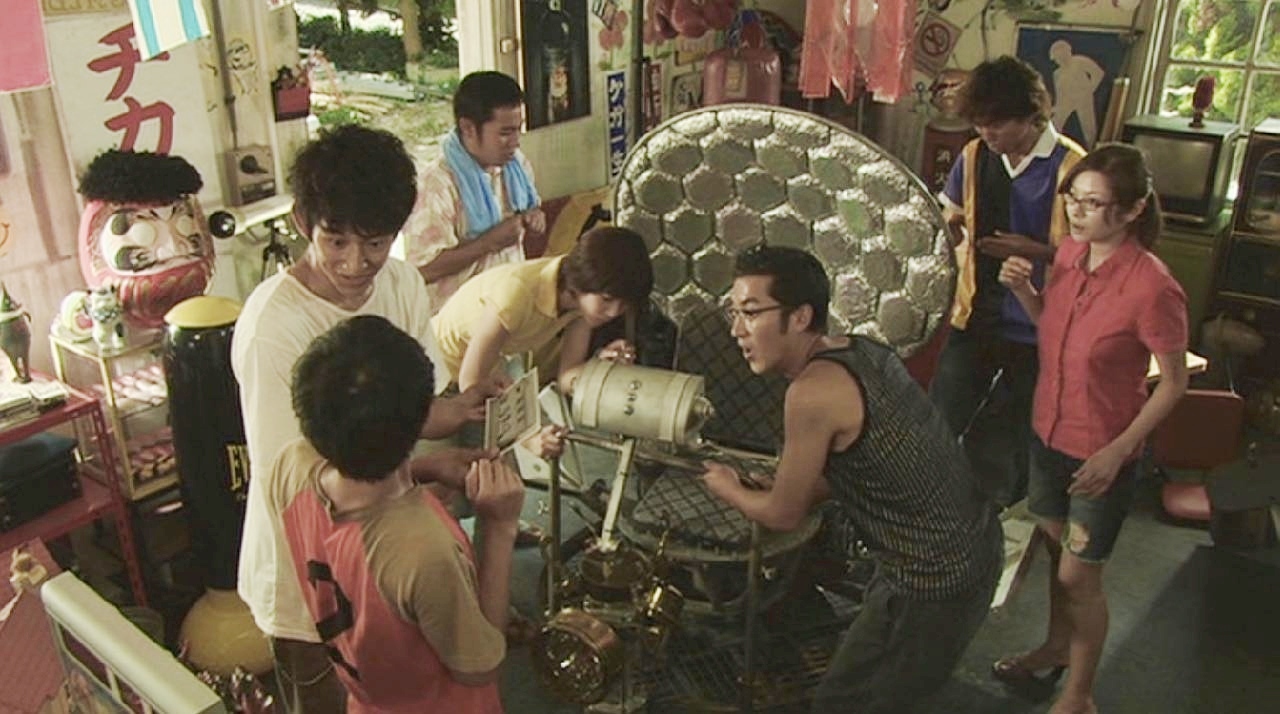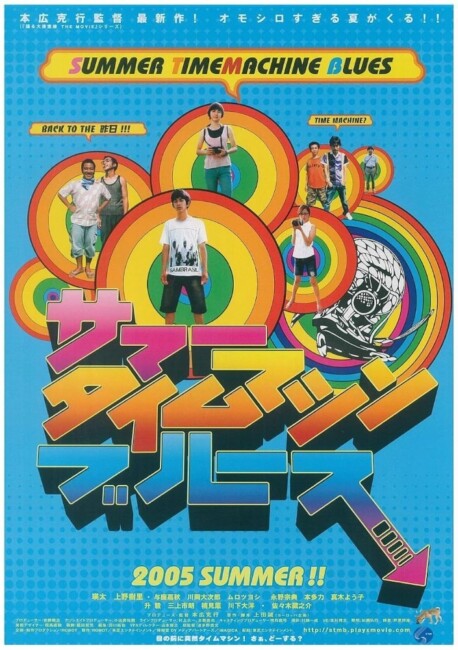(Sama Taimu Mashin Burusu)
Crew
Director – Katsuyuki Motohiro, Screenplay – Makoto Ueda, Producers – Chikahiro Andi & Katsuyuki Motohiro, Photography – Kazunari Kawagoe, Music – Halby & Strauss, Visual Effects Supervisor – Masayuki Yamamoto. Production Company – Toshiba Entertainment/Robot Communications Inc/Hakuhido DY Media Partners/Imagica.
Cast
Eita (Komoto Takuma), Munenori Nagano (Soga Atsushi), Yoshiaki Yoza (Niimi Masaru), Daijiro Kawaoka (Koizumi Shunsuke), Juri Ueno (Haruka Shibata), Yoko Maki (Ito Yui), Riki Honda (Tamura Akira), Tsuyoshi Muro (Ishimatso Daigo), Kuranosuke Sasaki (Professor Jose), Taiyo Kawashita (The Caretaker), Ichiro Mikami (Theatre Manager), Kaoru Kusumi (Public Bath Clerk)
Plot
Over the summer at university, a group of friends who form the Sci-Fi Club enjoy their time together. Problems are caused when an accidental string of events causes Coke to spill drink and destroy the remote control to the air conditioning system. They then discover that a time machine has appeared in the room. Desperate for relief from the sweltering heat, one of the group comes up with the idea of travelling back in time and obtaining the remote control before it was broken. They succeed in travelling back one day. Once there, they realise that removing the remote control from the timeline would cause a catastrophic disruption to causality. In trying to set things right, their travelling back and forward between the previous day and the present day causes a series of errors and events that has each of them running around while trying to avoid encountering themselves in order to preserve the integrity of the way things have happened.
Summer Time Machine Blues is a witty variant on the time travel film. It is a time travel film that, like many others of recent, acknowledges a debt of inspiration to Back to the Future (1985) – a poster for Back to the Future appears outside the theatre that Eita visits early in the film. Similarly, the time machine is closely modelled on the design in the classic George Pal adaptation of H.G. Wells’s The Time Machine (1960), which is the grandfather of the time travel movie. (In another piece of fanservice, the theatre manager wears a Star Trek: The Next Generation (1987-94) uniform top and there are posters of various Japanese and US science-fiction films around the walls of the classroom).
The film locates the time travel adventure within the environs of a high school/university, an area that Japanese cinema loves to set its youth films around. It is not that other filmmakers who pay homage to Back to the Future haven’t had similar ideas of locating a time travel film inside a high school/university setting – see the substantially less interesting Disney tv movie Minutemen (2008).
The basic idea of the time conundrum served up here draws more on the latter half of Back to the Future Part II (1989) than it does Back to the Future per se, which had the established characters running around the events of the first film trying to avoid themselves and set events aright. This does the same – and in even cleverer ways. Unlike Back to the Future Part II, there is not a pre-established first work to play off so the film becomes an extremely clever playing out of the characters from one day in the future trying to avoid their past selves to set things straight and prevent the entire continuum from collapsing.

This Summer Time Machine Blues does with an attention to continuity and detail that has you bursting our clapping at its cleverness by the end. Indeed, the end of the film comes with so many little additional throwaway gags and twists that keep being added after the main day has been won that it is positively hilarious. The various conundrums – how Eita becomes one day older than all the others, the explanation of the Kappa, Yoshiaki Yoza’s missing Vidal Sassoon shampoo, and especially the way the professor works out the convoluted timeline of the remote control and how it is essential to everything is positively side-splitting.
Everything comes together with a good deal of effortless and extremely good-natured humour. Summer Time Machine Blues is the sort of enormously clever, wildly entertaining and above all plot-driven type of film that Hollywood has forgotten how to make.
Director Katsuyuki Motohiro was previously most associated with the hit crime film Bayside Shakedown (1998), which has spawned a number of sequels. Motohiro also made the comedy Udon (2006), as well as several other genre entries such as the telepathy film Satorare (2001), the martial arts comedy Shaolin Girl (2008), Go Find a Psychic! (2009), Ajin (2017) about a demonic high school teenager, Laughing Under the Clouds (2018) about a mythic snake and Brave: Gunjyo Senki (2021) about a high school transported back in time to feudal Japan.


